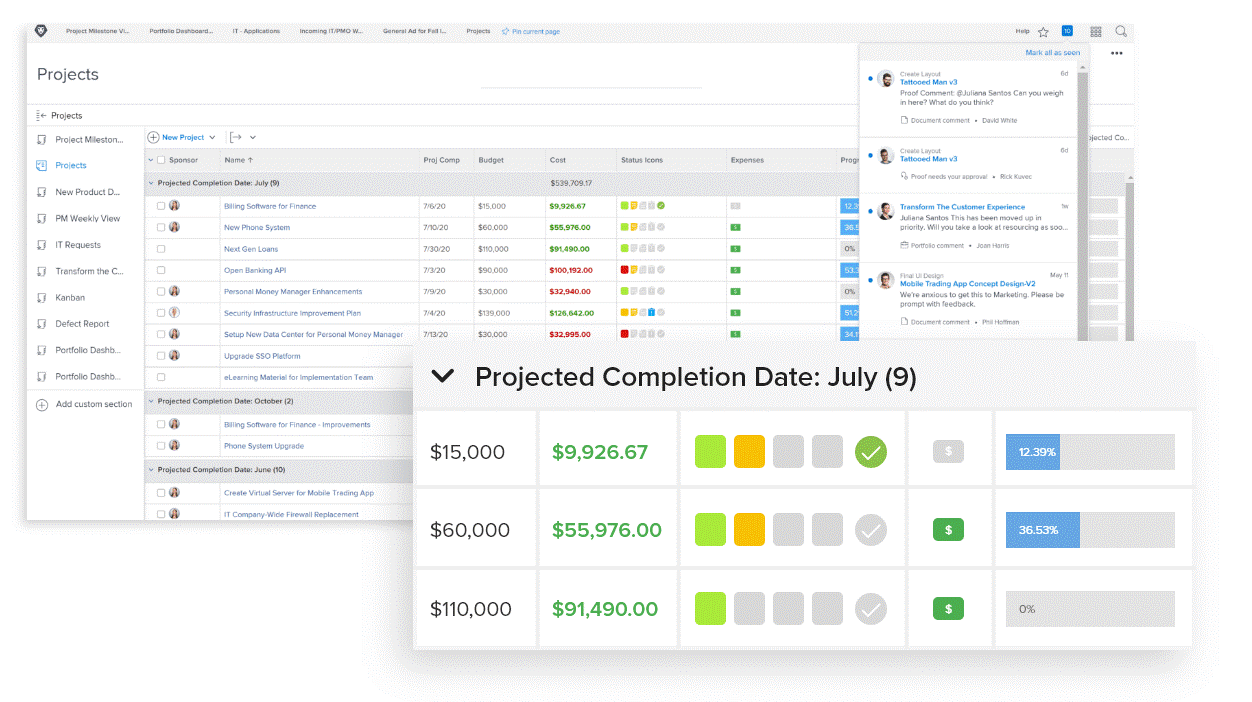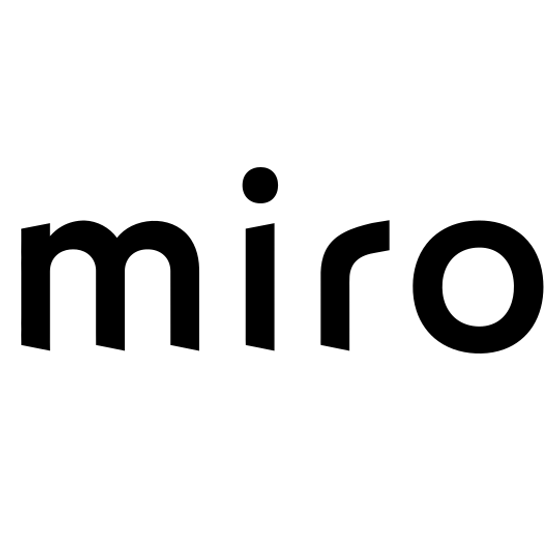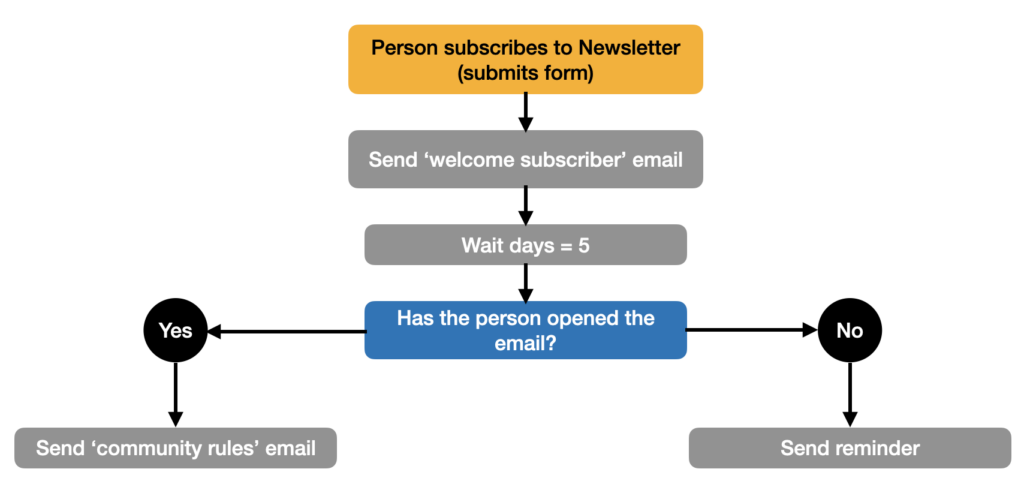10 Best Workflow Automation Software List
Here's my pick of the 10 best software from the 20 tools reviewed.
Managing complex projects manually soon becomes overwhelming. You make mistakes, miss necessary steps, and your team members get lost and confused in the resulting mess. That’s no way to run a business. Fortunately, workflow automation software is here to help.
Workflow automation software uses rule-based logic to run sequences of tasks without human intervention. You set up the rules once, and then the software takes care of getting things done. All you have to do is sit back, monitor progress, and hope you didn't mess up any of the steps, or it will need your intervention.
How I Picked The Best Workflow Automation Software
In picking the best workflow automation tool, I first researched the most popular software on the market for its reviews and user interface. Then I shortlisted based on factors that make software a good automation tool for any team. Finally, I used my experience in project automation to select the criteria by which I would evaluate the tools and inform my overviews.
Here’s a summary of my evaluation criteria:
User Interface (UI)
I look for workflow management tools that are visually attractive. Building workflow automations requires concentration, and you don't need a tool that requires brain power to figure it out.
Usability
I focus on all the ways in which the software helps you automate a manual process. This includes the use of a drag-and-drop builder
Integrations
I look for integrations with popular productivity apps and business tools. This includes built-in integrations with common apps like Google Drive or Slack, integrations through 3rd party software like Zapier, and custom integrations.
Pricing
I look for workflow automation that’s affordable, even for smaller organizations. Therefore, I include information on tool pricing based on monthly payments, free trials, demos and any information I find useful for you.
-

Native Teams
Visit WebsiteThis is an aggregated rating for this tool including ratings from Crozdesk users and ratings from other sites.4.9 -

Rippling
Visit WebsiteThis is an aggregated rating for this tool including ratings from Crozdesk users and ratings from other sites.4.8 -

Paylocity
Visit WebsiteThis is an aggregated rating for this tool including ratings from Crozdesk users and ratings from other sites.4.5
Overviews of the Best Workflow Automation Software
Here’s a brief description of each workflow automation system to showcase each tool’s best use case, some noteworthy features, and screenshots to give a snapshot of the user interface.
monday.com is a work management platform that has an automation module that helps you be more productive at work. The workflow automation features cut out repetitive tasks and ensure that your processes become standardized. As Ken Sarmadi puts it, “It’s one of the few platforms that can handle complex workflows and build interconnected systems effectively.”
Why I picked monday.com: I like its visual workflow builder, known as monday workflows. This tool allows you to create standardized workflows using drag-and-drop blocks that represent triggers, conditions, and actions. For example, you can set up a workflow that automatically assigns tasks to team members when a new item is created, adds a delay before sending a follow-up notification, and updates the task status based on specific conditions.
Another standout feature is the AI-powered workflow generator. By simply typing out a description of the workflow you want, such as "Manage and track incoming IT support requests," the AI can generate the entire workflow for you.
monday.com Standout Features & Integrations
Features include time-based automations that allow you to schedule recurring tasks or notifications at specific intervals. monday.com also supports dependency-based workflows, where tasks are automatically updated or triggered based on the completion of preceding tasks. Additionally, the platform's formula column allows you to automate calculations within your boards, making data-driven workflows more efficient.
Integrations include project management apps like Slack, Google Drive, Gmail, Typeform, Trello, Twilio, Google Calendar, Jira, GitHub, Trello, Dropbox, and Typeform. There are also thousands of additional apps you can connect to using a paid Zapier account.
Pros and cons
Pros:
- Easy to create notification flows
- Long list of supported integrations
- Easy to customize a workflow or board
Cons:
- May not be ideal for very complex workflows
- May be too robust for small teams
New Product Updates from monday.com
Visualize Board Data with WorkCanvas in monday.com
monday.com has introduced a new feature on WorkCanvas that allows users to visualize and style board data directly on their canvas, enhancing insights and context clarity. For more information, visit monday.com's official site.
Adobe Workfront is an enterprise work management solution that helps teams plan, manage, and deliver projects and maintain visibility across the organization. It’s for teams handling complex workflows that need control over schedules, resources, and approvals in one connected space.
Why I picked Adobe Workfront: I chose Adobe Workfront primarily for its process management software, which prioritizes requests, assigns work to teams, and automates approvals. From onboarding to delivery, digital assets are automatically built, reviewed, approved, and tagged to associated projects.
I also love how Workfront simplifies digital reviews and approvals, as well as providing real-time status updates. It accelerates content delivery by surfacing the correct information and tying project information to assets and social media, which I think makes it a great tool for working on large, enterprise-level projects.
Adobe Workfront Standout Features & Integrations
Features include scenario planning capabilities that allow you to model and compare different project strategies before implementation. Additionally, Workfront's compliance-ready audit trails provide full visibility into workflow changes, supporting enterprise-level governance and accountability.
Integrations include Frame.io, Creative Cloud, Box, Dropbox, Google Workspace, Jira, Microsoft Calendars (Office 365/Outlook Live), Microsoft OneDrive, Microsoft Outlook, Microsoft Teams, and Salesforce.
Pros and cons
Pros:
- Online proofing tools simplify version control
- Integration with BI tools like Tableau and Power BI
- Customizable dashboards and reports
Cons:
- Limited offline capabilities
- Integration setup can be time-consuming
New Product Updates from Adobe Workfront
Adobe Workfront's Transition to Unified Approvals
Adobe Workfront is transitioning from Legacy document approvals to Unified Approvals through a six-month phased rollout, starting automatically on July 17, 2025. More details at Adobe Experience League.
Qntrl is an advanced workflow orchestration software that improves productivity and efficiency in the workplace. At its core, it automates processes across different applications to reduce manual data entry and speed up workflows.
Why I picked Qntrl: I chose Qntrl for its strength in managing cross-functional processes through features like Blueprint-based process modeling, form-based data capture, and role-based access controls that ensure the right people are involved at the right steps.
Its drag-and-drop workflow builder enables non-technical users to quickly configure and launch end-to-end processes, while parallel transitions and stage-wise approvals allow multiple teams to collaborate simultaneously without bottlenecks. With built-in audit trails and customizable notifications, Qntrl keeps cross-departmental stakeholders informed and accountable throughout the workflow lifecycle.
Qntrl Standout Features & Integrations
Features include advanced SLA management that allows you to define and monitor timelines for each workflow step to ensure tasks are completed on time. Additionally, Qntrl offers dynamic conditional workflows that automatically routs and assigns tasks based on real-time data and specified conditions.
Integrations include applications such as Salesforce, Dropbox, MS Teams, Harvest, Google Sheets, and Slack. You can also create as many custom integrations as you want using Webhooks and its API.
Pros and cons
Pros:
- Employs robust security protocols
- Advanced automation, like conditional routing
- Extensive integration capabilities, with over 500 connections
Cons:
- May offer more features than necessary for smaller teams
- Learning curve for more advanced features
Miro is a collaborative online workspace that offers a visual platform for innovation, providing features such as visual project management, diagramming, process mapping, product development workflows, and more.
Why I picked Miro: While most workflow automation features are only possible with third-party integrations, Miro offers some key in-platform automation capabilities. These include templates for different types of workflows with customizable drag-and-drop interfaces, such as project planning, brainstorming, and sprints. It also offers smart diagramming with features like auto-align and auto-layout that can help automate the organization of elements within a board.
With integrations, Miro offers workflow automation like syncing project cards, providing updates in communication channels, and automating other project management functions.
Miro Standout Features & Integrations
Features include interactive automation triggers within boards that help teams set up actions, such as assigning tasks or sending notifications, based on specific changes or updates. Miro also supports cross-board linking to connect workflows and streamline processes across multiple projects.
Integrations include Box, Airtable, Notion, Azure, Webex, Jira, Asana, Microsoft Teams, Google Drive, Slack, Monday.com, Confluence, Zoom, and Figma.
Pros and cons
Pros:
- Miro integrates well with other tools
- The platform allows multiple users to collaborate simultaneously
- Wide range of templates available for various use case
Cons:
- Limited offline access
- Performance issues when working with large boards
New Product Updates from Miro
Introducing Canvas 25: Miro's Latest AI-Driven Innovations
Miro unveils ten AI-driven products and features, including the AI Innovation Workspace and Model Context Protocol, designed to enhance team productivity. For more information, visit Miro's official site.
Nanonets is an AI-driven platform that automates the processing of documents and manages workflows across sectors like finance, healthcare, and logistics. It efficiently handles tasks such as data extraction, invoice processing, and accounts payable, minimizing manual labor and reducing processing times.
Why I picked Nanonets: I chose Nanonets for its AI-driven capabilities that can automate complex workflows using natural language processing, allowing you to manage workflows that interact with various apps and data sources. The platform supports custom Language Learning Models (LLMs) for tailored responses and actions, enhancing workflow customization to meet specific business needs. This lets you design workflows that are automated and adaptive to unique business environments.
Additionally, Nanonets offers a human-in-the-loop feature for manual approvals, providing an extra layer of accuracy in automated workflows. It's also a no-code platform, so you can automate these workflows without coding expertise.
Nanonets Standout Features & Integrations
Features include multi-step workflow automations that allow users to design end-to-end workflows that handle tasks such as data validation, approvals, and updates. Additionally, Nanonets offers real-time data monitoring to provide instant updates on workflow status.
Integrations include Quickbooks, Salesforce, Google Sheets, Dropbox, and Zapier.
Pros and cons
Pros:
- Simple API for easy integration
- Compatible with multiple programming languages
- Data extraction features
Cons:
- Fewer customization options than other tools
- May not be suitable for more extensive machine learning projects with large datasets
Jotform Workflows is a no-code automation tool designed to improve workflow management and streamline approval processes within organizations. It allows users to build customized workflows that automate tasks and enhance collaboration through an intuitive drag-and-drop interface.
Why I picked Jotform Workflows: In my opinion, Jotform Workflows is standout option for workflow automation, primarily due to its intuitive no-code workflow builder. With this feature, you can design custom workflows with ease using a drag-and-drop interface, making it accessible for users without a technical background.
Additionally, I found Jotform Workflows' strong automation capabilities, including conditional logic, parallel processing, and automated approvals, highly valuable as they manage to effortlessly address diverse organizational needs such as employee onboarding and budget approvals.
Jotform Workflows Standout Features & Integrations
Features include real-time progress tracking that allows teams to monitor the status of workflows and approvals for improved transparency and accountability. Jotform Workflows also supports advanced task dependencies, enabling users to establish relationships between tasks to ensure processes are executed in the correct order.
Integrations include several top software, such as Microsoft Teams, Slack, Google Sheets, Zoom, Google Calendar, Zoho CRM, and Pipedrive. Jotform Workflows also connects to Zapier to help users connect to thousands of other software options.
Pros and cons
Pros:
- Provides automated email notifications to keep stakeholders informed
- Supports parallel processing to handle multiple tasks simultaneously
- Offers flexible conditional logic and branching for dynamic workflows
Cons:
- Workflow customization post-form submission can be cumbersome.
- Customization options for the visual interface could be more advanced
Studio Creatio is a no-code platform that enables businesses to automate workflows and build applications without the need for extensive coding knowledge.
Why I picked Studio Creatio: The platform is highly customizable, featuring a No-Code Designer, which includes tools for creating and modifying pages, views, data models, workflows, and integrations within a single workspace. The platform also offers industry-specific solutions for sectors such as banking, credit unions, and insurance.
Studio Creatio's workflow automation software is part of this no-code platform. Users can design, automate, and optimize workflows with an intuitive visual interface that requires no prior programming knowledge. This feature makes the technology accessible to a broad range of professionals to help contribute to the digital transformation of their business.
Studio Creatio Standout Features & Integrations
Features include case management capabilities that enable businesses to adapt workflows in real-time based on unique scenarios. Studio Creatio also supports AI-powered process recommendations that can help users identify opportunities to optimize and automate their workflows further.
Integrations include Chat Master, PandaDoc, SharePoint, Jira, Calendly, Zoom, Shopify, Asterisk, Microsoft Teams, Zapier, Quickbooks, SAP BusinessOne, and more.
Pros and cons
Pros:
- Support for AI process recommendations
- No-code designer makes it easier to adopt for non-technical users
- Fully customizable platform, adaptable to various use cases
Cons:
- Not ideal for teams looking for a quick-start solution
- May take significant effort planning and designing workflows
Camunda is a workflow automation software that helps teams design, execute, and manage complex business processes.
Why I picked Camunda: Camunda's Zeebe engine is built for high-throughput, distributed environments, making it ideal for automating high-volume, mission-critical processes. It avoids traditional database bottlenecks by using an event-driven architecture, allowing you to process thousands of workflow instances per second with low latency. This is especially useful if you're orchestrating microservices, APIs, or systems that require fast, reliable automation.
I also like its ability to handle both automated and human tasks within the same process. You can assign user tasks, manage RPA bots, and automate decisions all in one flow. Its native support for BPMN and DMN ensures that what you model is exactly what runs, giving you full control and transparency over your workflows.
Camunda Standout Features & Integrations
Features include built-in tools for testing and deploying workflows, allowing you to simulate processes before they go live. This helps catch issues early and ensures smoother deployments. Camunda also provides real-time monitoring through its Operate component, so you can track running processes, identify bottlenecks, and resolve incidents quickly.
Integrations include Salesforce, Microsoft Dynamics, SAP, Oracle, Microsoft SharePoint, Alfresco, Apache Kafka, RabbitMQ, MySQL, PostgreSQL, Microsoft SQL Server, Amazon Web Services (AWS), Microsoft Azure, Google Cloud Platform (GCP), Signavio, Bizagi, and ProcesMaker.
Pros and cons
Pros:
- Provides visibility into running processes
- Camunda's API-first approach makes it easy to integrate with various systems
- Offers highly scalable architecture
Cons:
- Running Camunda at scale may require significant infrastructure resources
- Steep learning curve, not beginner friendly
Kissflow Workflow is a no-code workflow management and automation software that can help teams track and improve their processes and identify bottlenecks.
Why I picked Kissflow Workflow: I chose Kissflow Workflow for this list because of the software's large bank of workflow templates that users can choose. You can can also opt to build your own. Additionally, the drag-and-drop form builder is accessible to people without coding experience, which I think makes it perfect for helping any type of team set up a standardized request process. Built with simplicity in mind, the software's visual workflows help give a high-level picture to spot opportunities to streamline or eliminate bottlenecks. I also like how Kissflow's pre-built reports can help teams track their productivity and efficiency over time.
Kissflow Workflow Standout Features & Integrations
Features include rule-based task assignments that automatically route tasks to the right team members based on predefined criteria. Kissflow Workflow also offers multi-level approval workflows that allow teams to set up sequential or parallel approval processes. Additionally, its built-in notifications and reminders help ensure that no tasks or deadlines are overlooked, keeping workflows on track.
Integrations includes many enterprise-friendly connectors like MailChimp, ActiveCampaign, DocuSign, Basecamp, Dropbox, Quickbooks, Google Workspace, and Slack. You can also build custom integrations using Kissflow APIs.
Pros and cons
Pros:
- Audit trails and user actions for compliance
- Scale basic processes as your team grows
- Launch no-code workflows without IT help
Cons:
- Difficult to change published workflows
- You might hit customization limits for complex workflows
Pneumatic is a workflow management software that allows you to build and automate workflows for your business processes. You can organize your workflows into templates for easier reproduction and quicker creation in the future.
Why I picked Pneumatic Workflow: I selected Pneumatic Workflow for this list because its workflow builder can be used to create any task or workflow you need for your team. I'm particularly impressed by how users can establish pre-defined variables like names, assignees, descriptions, and required policies or standard operating procedures (SOPs) to apply to different workflows. Once you've built a workflow template, the dashboards help you track what's progress, started, and completed.
I also like how you can include external parties in your workflow and easily invite guests by email. Admins can also use the workflow management software to configure role-based access permissions for individual staff members and teams.
Pneumatic Workflow Standout Features & Integrations
Features include task prioritization capabilities that allow users to assign and reorder tasks within workflows based on urgency or importance. Pneumatic also supports multi-step workflows with branching logic, enabling task routing based on real-time decisions or conditions. You can even generate filtered and customized reports to understand your workflow performance and receive weekly process summaries.
Integrations can be built with the system's API, or configured by connecting either Zapier or Make.
Pros and cons
Pros:
- Automation within the tool assists in simplifying workflows
- Facilitates collaboration among team members
- Customizable workflow templates
Cons:
- Performance may vary depending on workflow complexity
- Not many built-in software integrations
The 10 Best Workflow Automation Software Comparison Chart
This comparison chart summarizes basic details about each of my top workflow automation software selections. You can view pricing details and the availability of free trials or demos side-by-side to help you find the best platform that works for your budget.
| Tool | Best For | Trial Info | Price | ||
|---|---|---|---|---|---|
| 1 | Best for standardizing processes | 14-day free trial + free plan available | From $8/user/month (billed annually) | Website | |
| 2 | Best for comprehensive project oversight | Free trial available | Pricing upon request | Website | |
| 3 | Best for cross-functional processes | 15-day free trial | From $19/user/month (billed annually) | Website | |
| 4 | Best for drag-and-drop workflows | Free plan available | From $8/user/month (billed annually) | Website | |
| 5 | Best for custom LLMs | Free demo available | Pricing upon request | Website | |
| 6 | Best for no-code workflow building | Free plan available | From $34/month (billed annually) | Website | |
| 7 | Best for workflow customization | 14-day free trial | From $25/user/month | Website | |
| 8 | Best for high-volume automation | 30-day free trial | Pricing upon request | Website | |
| 9 | Best for non-technical users | Free demo available | From $2,500/month | Website | |
| 10 | Best for templated workflows | 7-day free trial | From $99/month (unlimited users) | Website |
Other Tools
- Integrately
For an AI automation builder
- Boomi Flow
For low-code workflow automation
- ClickUp
For workflow automation flexibility
- Smartsheet
For dynamic workflows
- SysAid
For IT service management
- Hive
For beginners
- Kantata
For professional services
- StreamWork
For creative workflows
- DocuWare
For document management
- Make
For visual-first automation
Workflow Automation FAQs
Find answers to common questions about this topic.
What is workflow automation?
What is workflow automation software?
Why is workflow automation important?
What is a workflow automation example?
What features should I look for when selecting workflow automation software?
What other tools have workflow automation?
What's Next?
Also, make sure you subscribe to the Digital Project Manager newsletter. You’ll get fascinating insights into this fast-moving world, together with the information you need to stay on top of your professional game.
Related tool lists:


























